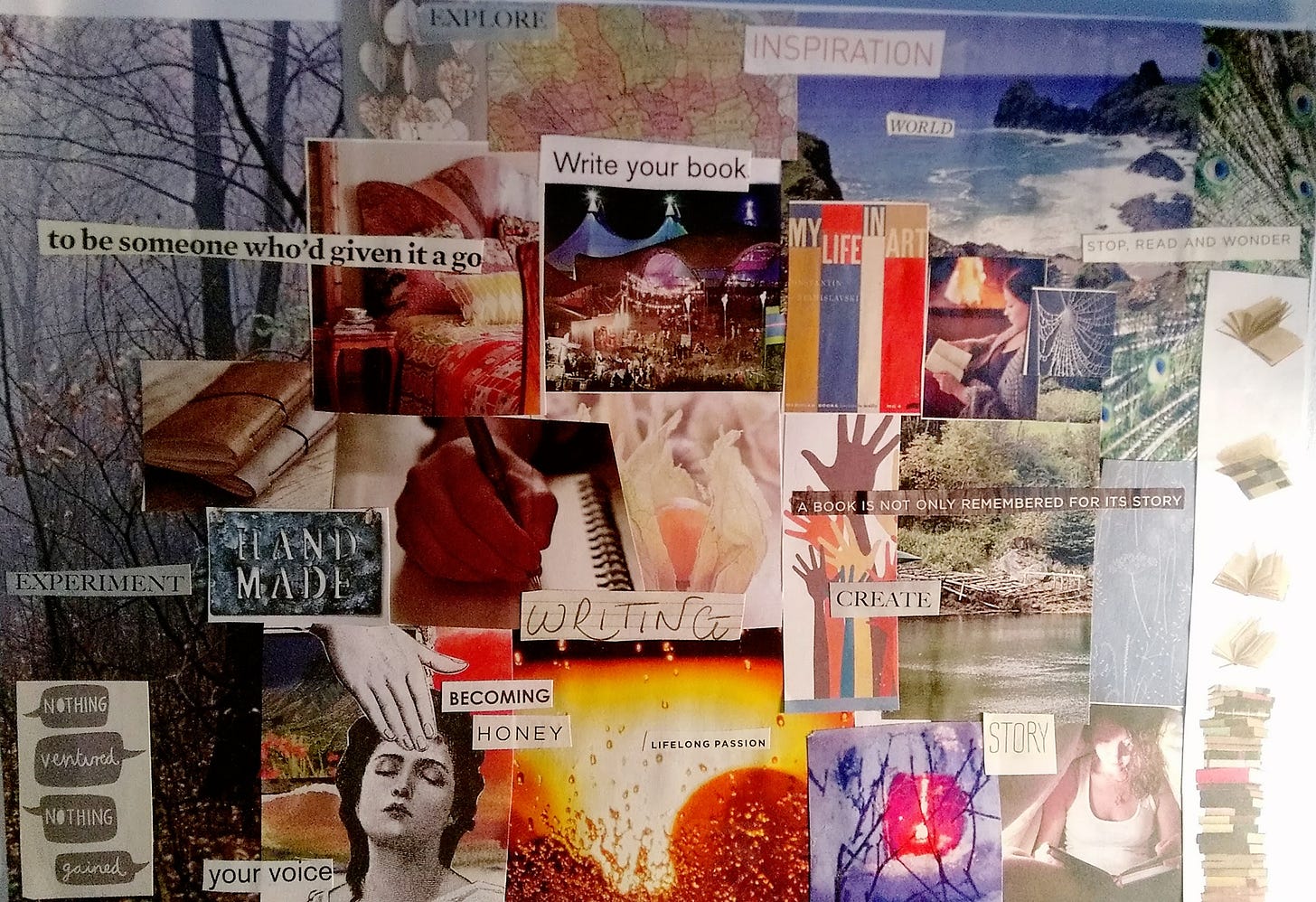My Book Writing Adventure | Dec 24 | No. 3
The third post in my experimental, self-directed, gentle book coaching programme: research | noticing | peer coaching | visioning.
In this post, you will find:
A review of my experiments in the past month.
A link to My Book Writing Adventure programme index (this list of what to expect for the next 12 months is for paid subscribers).
Gentle suggestions and ideas for what you can do on your book project in the next lunar month.
An invitation to the full moon My Book Writing Adventure Support Group on Zoom - Sunday 15 November 4-5pm GMT (for paid subscribers).
My Book Writing Adventure is a gentle, experimental, pick ‘n’ mix, self-directed book coaching programme for people with full enough lives who are driven to write a book despite everything.
I am committed to writing a book, creating a series of experiments to help me and inviting people along for the ride. There is a monthly newsletter (free and published each new moon) and a monthly support group on Zoom (for paid subscribers around the full moon).
It is important that we tell and share our authentic stories (in a world of increasing ai).
If you missed the first two posts, click here:
Click the button below to subscribe or upgrade your subscription. And scroll down for this month’s update.
My book writing experiments
I will begin by reviewing my past month and what I’ve been working on and then offer small suggestions as to what you could do.
Support Group
#wellbeing
Our full moon support group was again so welcome. There’s something about giving ourselves the space to talk about our projects and be listened to. To help with this project, I am joining in with a peer coaching group run by the lovely Becky Seale. Each time I give space to allow someone to listen to my thoughts in an intentional way, I realise something new.
In the support group this time, I realised I couldn’t say clearly what my book is about in a sentence or two. This is so important and really helped me think about it afterwards and reconnect with the purpose of the book as well.
What you could do:
Join us next time! Sunday 15th December 4-5pm (for paid subscribers). Click the orange button in the top right-hand corner of your screen to upgrade.
Noticing
#wellbeing
This time last year, I began a photo journal. I’ve never done this before. But it’s been brilliant for noticing the beautiful moments in life. It is very informal. I have a notes app on my phone and now and then I save one or two photos from my week with a caption. This helps me remember everything I’ve done this year in a really concise, visual way and it also provides a record if I want to go back and write about something.
What you could do:
Keep a noticing journal (separate to freewriting; similar to a gratitude journal). This can be visual (photos, sketches) or written (fragments, maybe haiku).
Things to notice:
colours
seasonal changes
weather
shapes & patterns
moods
sounds
tastes
mannerisms
colloquialisms
If you’d like more of a framework with prompts,
has a lovely printed journal for reflection and wellbeing: Weather Report.Research
#practice
I love to research. So much so that other people have noticed and paid me as a freelance researcher. The first time I did this I couldn’t believe that I was being paid to look things up!
These are the ways I use research in my writing:
To verify facts and add depth and detail.
For context. To find out what else has been written in the area I’m working in and see what I can add.
For techniques. I often look at other writing for inspiration and to see how they tackled something. (For example - the balance of dialogue, description and action when writing a scene.)
With all of this research, both for my workshops and my writing, I need a system. I am forever looking for the perfect system! Here are some systems that I’ve been working with and that you could try too:
Commonplace book
Recently, I’ve been trying out keeping a commonplace book. This is a small notebook where you jot down quotes, ideas and thoughts mainly from other people (rather than a journal, which is your own thoughts and feelings). You can have themes as headers, then an index at the front. Or just write the quotes as you come across them. You can also allow space to respond to the quotes in your own words. Or not. It’s up to you.
I’m using one for my workshops right now. I have varied headers such as: Spring; Characters; Poetic form; Developing self-belief; Weather; Experimenting with language. Then under each one, I have a note about a writing exercise or prompt, a poem, book title, or quote. This is really helping me remember what I’ve done and make connections as well.
Here’s how
uses hers. And here’s Ruby Granger with a YouTube video explaining how she uses hers.Personal knowledge system
I guess one of the most influential ideas for me has been to create a personal knowledge system for myself. I read the book: Building a Second Brain by Tiago Forte as well as information on the Zettelkasten method or making linked notes on index cards. The idea behind all of this is to create links between your ideas and to build up a body of work over a lifetime, so when you write something you never have to start from scratch. You begin with the ideas and notes you have already.
I am not great at following one system, so my notes are still all over the place, but Capacities App seems to be working for and with my messy, creative brain right now, mirroring the way I think.
Dump document
This is research at its most basic. Always have one of these alongside your working draft document for each project no matter what other system you are using! Your dump document is a place to store links, notes, quotes and other ideas related to a particular project. In my early days as a freelance writer, I would begin with one of these. Then it would evolve into a document with themed headers, where I cut and pasted the notes from my dump document. I’d call this “Dump Document Organised”!
What you could do:
Whatever the level of research you need to do or are comfortable doing, create a system to save your notes and links in one place. This could be one document or notebook, a series of themed documents or a whole personal knowledge management system.
Visioning
#magic
About 10 years ago, I really wanted my work to shift in a more creative direction, but I didn’t know how to make that happen. I took a pile of magazines, tore out pictures, then stuck them on an A3 sheet:
Then I forgot about it.
Two years later after thinking of HoneyLeaf Writing as a name for my creative writing workshops venture, I found this collage and noticed the words “becoming honey” on it. This felt insignificant at the time but so important later. Honey is a family name - it was my grandmother’s maiden name and someone from each generation of women has carried it as a middle name.
I really feel as if this collage has shaped my direction since then.
I also used this process when I was working with a mythic character for a poetry project to help solidify her in my mind.
What you could do:
You can do this for your book. Set aside a couple of hours of quiet time (if you don’t have a couple of hours, you can do this in stages - cutting out the pictures or words first, then sticking them in another session). Gather a pile of magazines, a glue stick and a piece of card or large paper or a double page spread in an A4 notebook. Go through them tearing out a pile of words, phrases or pictures you are drawn to. Don’t question why. Pick some to spread out and place them on your blank sheet. Glue in place. Journal in response to it if you would like to.
To join the full moon My Book Writing Adventure support group (Zoom) on Thursday 17 October 1-2pm, if you are a paid subscriber, click here for the link. I will also send a reminder nearer the time. If not, upgrade by clicking this button:
What gentle things will you do this month to move your book project forward?
I’d love to hear about it - leave a comment below :)
Until next time…









Mel, thank you for mentioning my work in this very rich post. Some wonderful and actionable ideas here.